Impacts of Corporate Governance on Financial Performance Report
VerifiedAdded on 2020/03/16
|33
|8452
|167
Report
AI Summary
This report investigates the impacts of corporate governance on the financial performance of business organizations. It begins by defining corporate governance and its components, including CEO duality, board size, and board composition. The report then explores the connection between corporate governance and financial performance, drawing on existing literature to analyze the positive and negative relationships. The research aims to determine how CEO duality, board size, and board composition affect the financial performance of corporations. The study highlights the importance of sound corporate governance in today's global financial environment, where investors seek strategies to prevent financial losses. The report's objectives include discussing the components of corporate governance, examining the connection between corporate governance and financial performance, and finding out the effects of CEO duality, board size, and board composition on financial performance. The study concludes with recommendations for further research in this area.
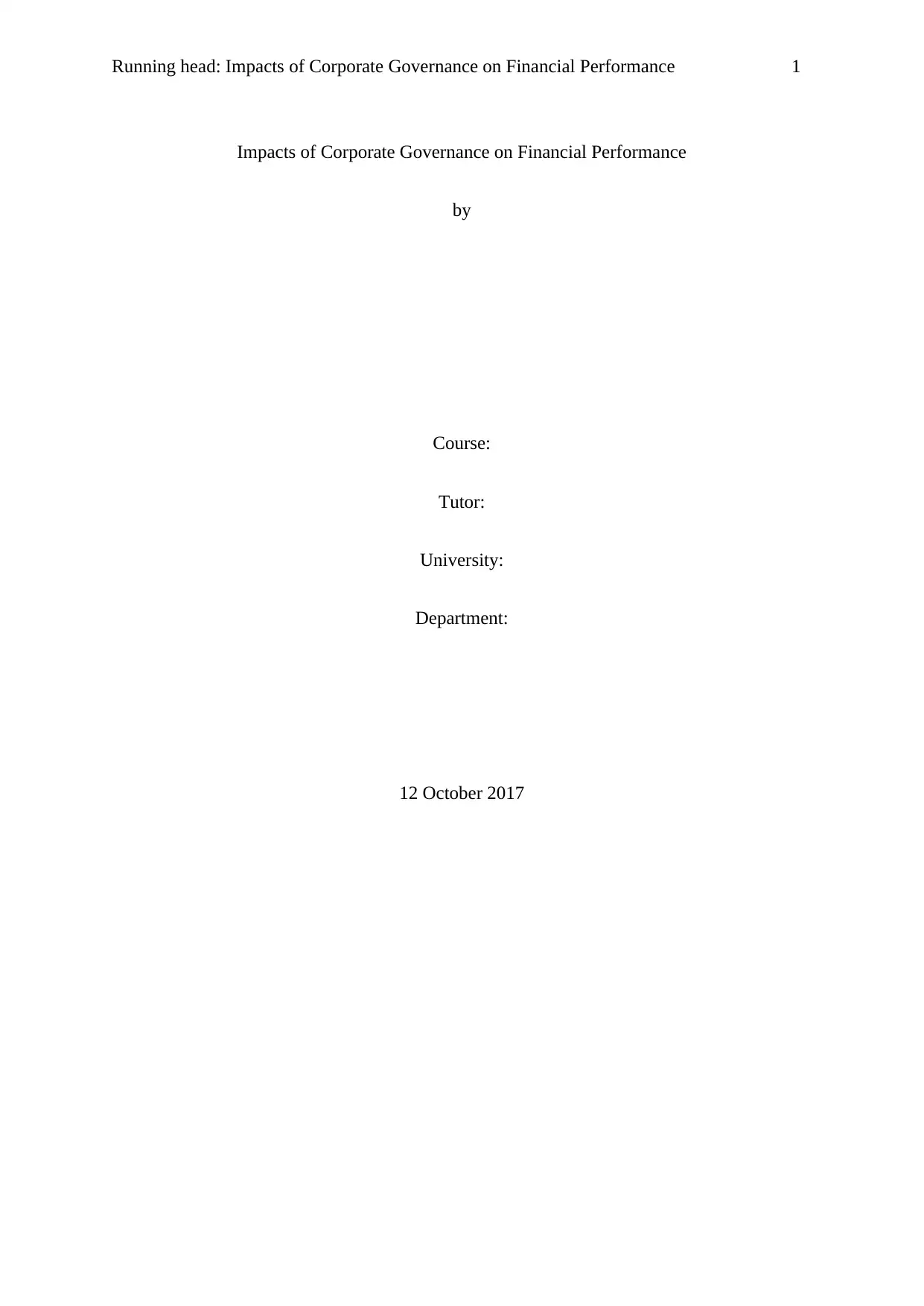
Running head: Impacts of Corporate Governance on Financial Performance 1
Impacts of Corporate Governance on Financial Performance
by
Course:
Tutor:
University:
Department:
12 October 2017
Impacts of Corporate Governance on Financial Performance
by
Course:
Tutor:
University:
Department:
12 October 2017
Paraphrase This Document
Need a fresh take? Get an instant paraphrase of this document with our AI Paraphraser
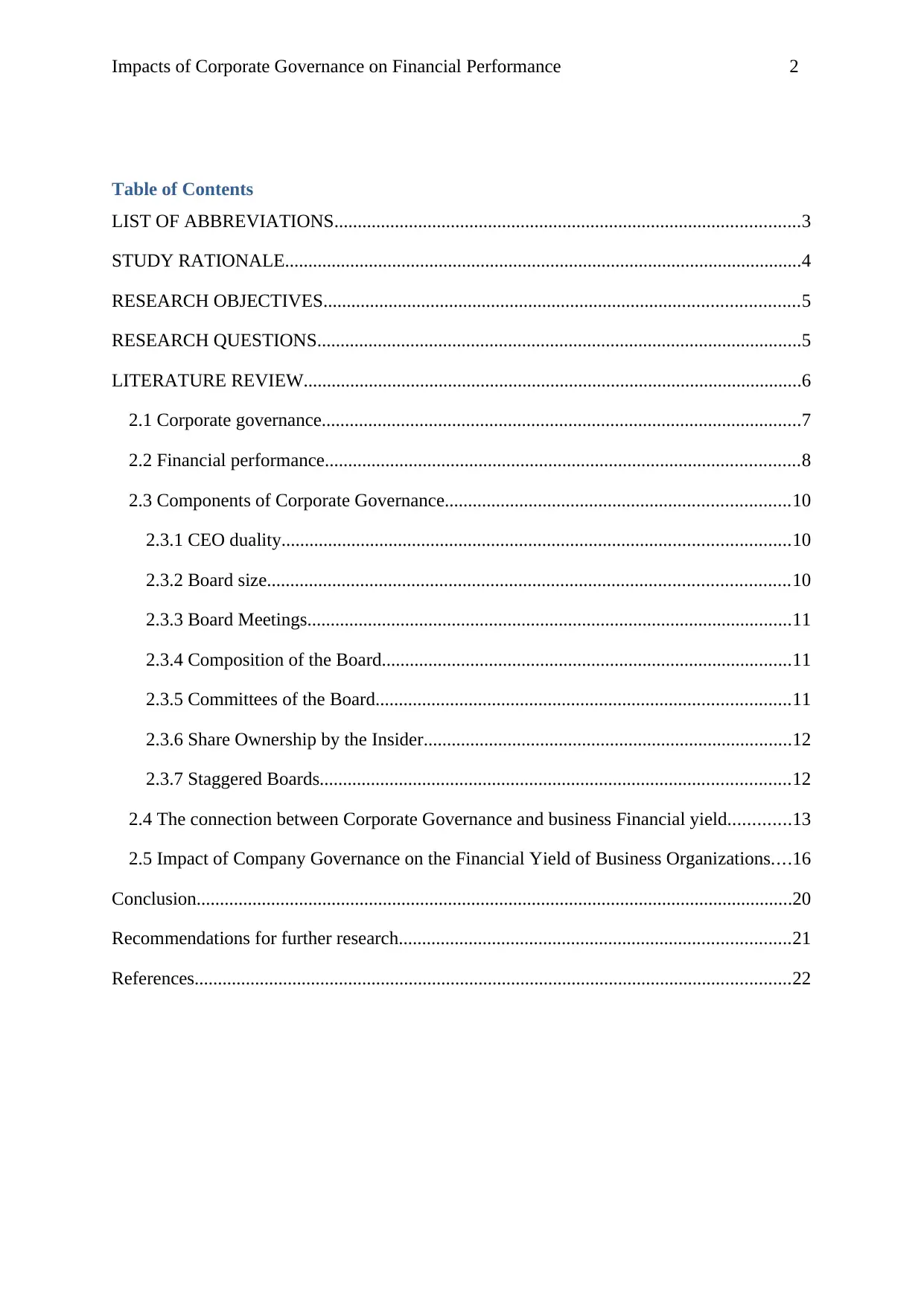
Impacts of Corporate Governance on Financial Performance 2
Table of Contents
LIST OF ABBREVIATIONS....................................................................................................3
STUDY RATIONALE...............................................................................................................4
RESEARCH OBJECTIVES......................................................................................................5
RESEARCH QUESTIONS........................................................................................................5
LITERATURE REVIEW...........................................................................................................6
2.1 Corporate governance.......................................................................................................7
2.2 Financial performance......................................................................................................8
2.3 Components of Corporate Governance..........................................................................10
2.3.1 CEO duality.............................................................................................................10
2.3.2 Board size................................................................................................................10
2.3.3 Board Meetings........................................................................................................11
2.3.4 Composition of the Board........................................................................................11
2.3.5 Committees of the Board.........................................................................................11
2.3.6 Share Ownership by the Insider...............................................................................12
2.3.7 Staggered Boards.....................................................................................................12
2.4 The connection between Corporate Governance and business Financial yield.............13
2.5 Impact of Company Governance on the Financial Yield of Business Organizations....16
Conclusion................................................................................................................................20
Recommendations for further research....................................................................................21
References................................................................................................................................22
Table of Contents
LIST OF ABBREVIATIONS....................................................................................................3
STUDY RATIONALE...............................................................................................................4
RESEARCH OBJECTIVES......................................................................................................5
RESEARCH QUESTIONS........................................................................................................5
LITERATURE REVIEW...........................................................................................................6
2.1 Corporate governance.......................................................................................................7
2.2 Financial performance......................................................................................................8
2.3 Components of Corporate Governance..........................................................................10
2.3.1 CEO duality.............................................................................................................10
2.3.2 Board size................................................................................................................10
2.3.3 Board Meetings........................................................................................................11
2.3.4 Composition of the Board........................................................................................11
2.3.5 Committees of the Board.........................................................................................11
2.3.6 Share Ownership by the Insider...............................................................................12
2.3.7 Staggered Boards.....................................................................................................12
2.4 The connection between Corporate Governance and business Financial yield.............13
2.5 Impact of Company Governance on the Financial Yield of Business Organizations....16
Conclusion................................................................................................................................20
Recommendations for further research....................................................................................21
References................................................................................................................................22

Impacts of Corporate Governance on Financial Performance 3
LIST OF ABBREVIATIONS
ROA Return on Assets
CMA Capital Markets Authority
SACCO Savings and Credit Cooperative Organization
ROE Return on Equity
(ROC) Return on Capital
LIST OF ABBREVIATIONS
ROA Return on Assets
CMA Capital Markets Authority
SACCO Savings and Credit Cooperative Organization
ROE Return on Equity
(ROC) Return on Capital
⊘ This is a preview!⊘
Do you want full access?
Subscribe today to unlock all pages.

Trusted by 1+ million students worldwide
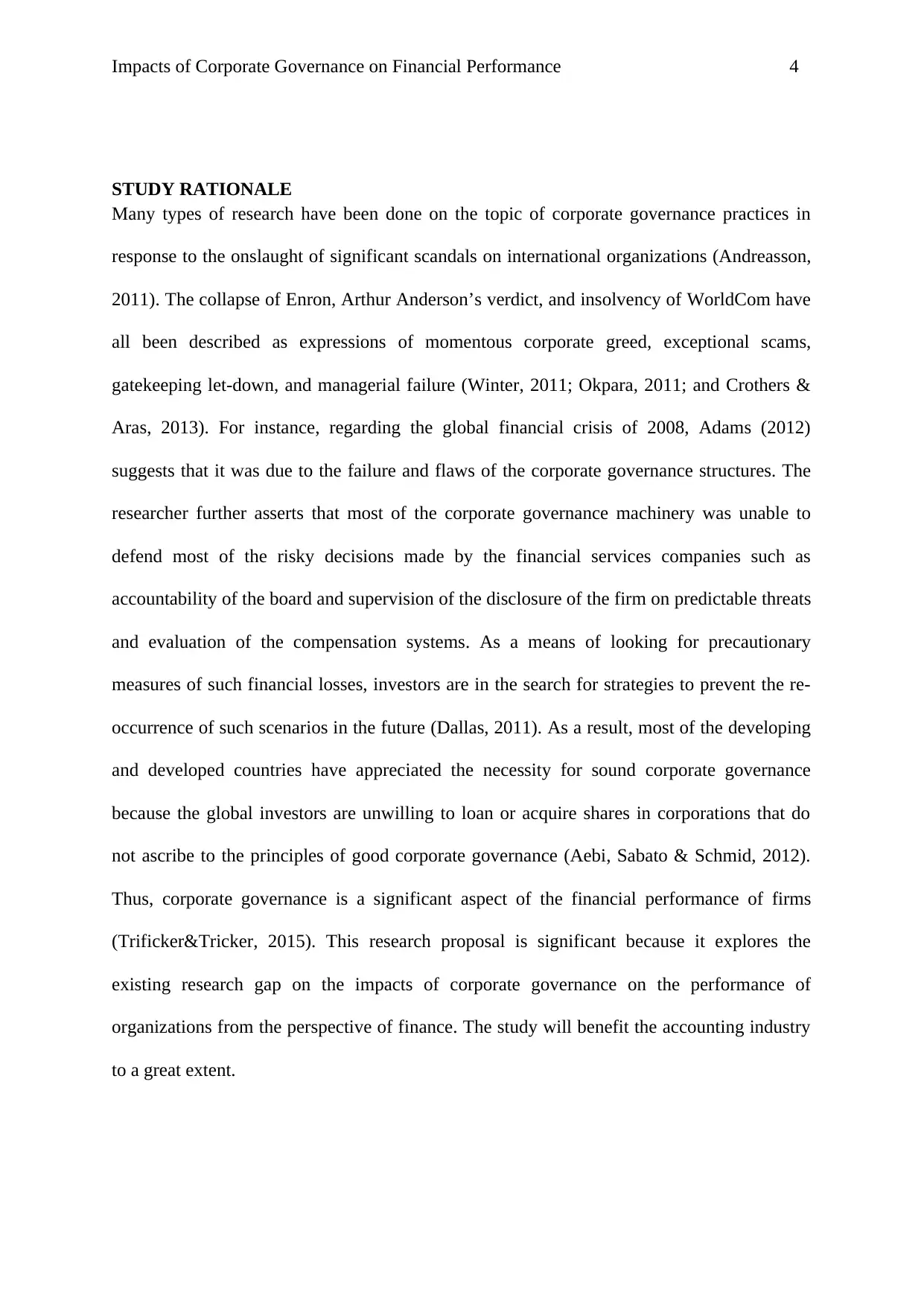
Impacts of Corporate Governance on Financial Performance 4
STUDY RATIONALE
Many types of research have been done on the topic of corporate governance practices in
response to the onslaught of significant scandals on international organizations (Andreasson,
2011). The collapse of Enron, Arthur Anderson’s verdict, and insolvency of WorldCom have
all been described as expressions of momentous corporate greed, exceptional scams,
gatekeeping let-down, and managerial failure (Winter, 2011; Okpara, 2011; and Crothers &
Aras, 2013). For instance, regarding the global financial crisis of 2008, Adams (2012)
suggests that it was due to the failure and flaws of the corporate governance structures. The
researcher further asserts that most of the corporate governance machinery was unable to
defend most of the risky decisions made by the financial services companies such as
accountability of the board and supervision of the disclosure of the firm on predictable threats
and evaluation of the compensation systems. As a means of looking for precautionary
measures of such financial losses, investors are in the search for strategies to prevent the re-
occurrence of such scenarios in the future (Dallas, 2011). As a result, most of the developing
and developed countries have appreciated the necessity for sound corporate governance
because the global investors are unwilling to loan or acquire shares in corporations that do
not ascribe to the principles of good corporate governance (Aebi, Sabato & Schmid, 2012).
Thus, corporate governance is a significant aspect of the financial performance of firms
(Trificker&Tricker, 2015). This research proposal is significant because it explores the
existing research gap on the impacts of corporate governance on the performance of
organizations from the perspective of finance. The study will benefit the accounting industry
to a great extent.
STUDY RATIONALE
Many types of research have been done on the topic of corporate governance practices in
response to the onslaught of significant scandals on international organizations (Andreasson,
2011). The collapse of Enron, Arthur Anderson’s verdict, and insolvency of WorldCom have
all been described as expressions of momentous corporate greed, exceptional scams,
gatekeeping let-down, and managerial failure (Winter, 2011; Okpara, 2011; and Crothers &
Aras, 2013). For instance, regarding the global financial crisis of 2008, Adams (2012)
suggests that it was due to the failure and flaws of the corporate governance structures. The
researcher further asserts that most of the corporate governance machinery was unable to
defend most of the risky decisions made by the financial services companies such as
accountability of the board and supervision of the disclosure of the firm on predictable threats
and evaluation of the compensation systems. As a means of looking for precautionary
measures of such financial losses, investors are in the search for strategies to prevent the re-
occurrence of such scenarios in the future (Dallas, 2011). As a result, most of the developing
and developed countries have appreciated the necessity for sound corporate governance
because the global investors are unwilling to loan or acquire shares in corporations that do
not ascribe to the principles of good corporate governance (Aebi, Sabato & Schmid, 2012).
Thus, corporate governance is a significant aspect of the financial performance of firms
(Trificker&Tricker, 2015). This research proposal is significant because it explores the
existing research gap on the impacts of corporate governance on the performance of
organizations from the perspective of finance. The study will benefit the accounting industry
to a great extent.
Paraphrase This Document
Need a fresh take? Get an instant paraphrase of this document with our AI Paraphraser
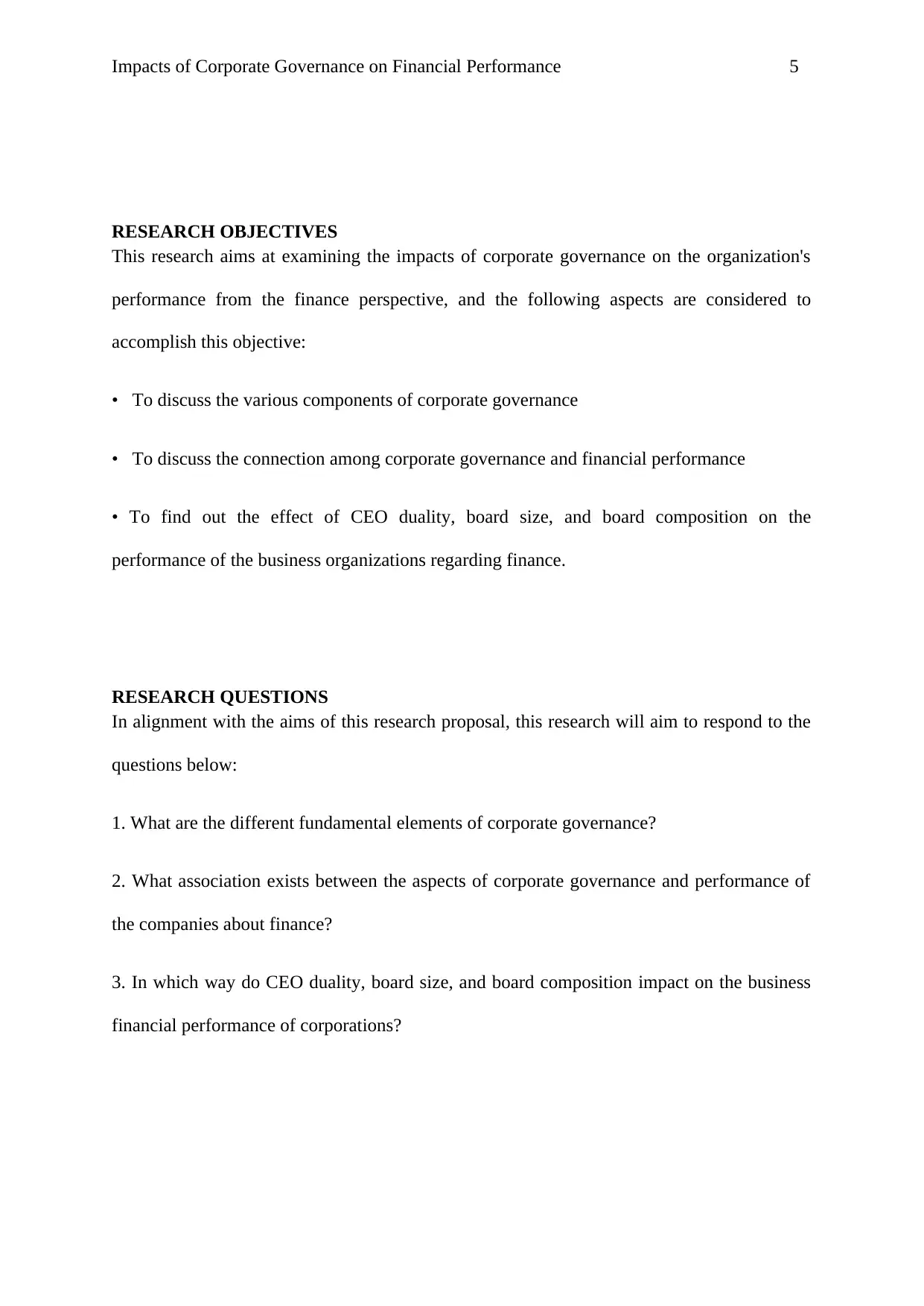
Impacts of Corporate Governance on Financial Performance 5
RESEARCH OBJECTIVES
This research aims at examining the impacts of corporate governance on the organization's
performance from the finance perspective, and the following aspects are considered to
accomplish this objective:
• To discuss the various components of corporate governance
• To discuss the connection among corporate governance and financial performance
• To find out the effect of CEO duality, board size, and board composition on the
performance of the business organizations regarding finance.
RESEARCH QUESTIONS
In alignment with the aims of this research proposal, this research will aim to respond to the
questions below:
1. What are the different fundamental elements of corporate governance?
2. What association exists between the aspects of corporate governance and performance of
the companies about finance?
3. In which way do CEO duality, board size, and board composition impact on the business
financial performance of corporations?
RESEARCH OBJECTIVES
This research aims at examining the impacts of corporate governance on the organization's
performance from the finance perspective, and the following aspects are considered to
accomplish this objective:
• To discuss the various components of corporate governance
• To discuss the connection among corporate governance and financial performance
• To find out the effect of CEO duality, board size, and board composition on the
performance of the business organizations regarding finance.
RESEARCH QUESTIONS
In alignment with the aims of this research proposal, this research will aim to respond to the
questions below:
1. What are the different fundamental elements of corporate governance?
2. What association exists between the aspects of corporate governance and performance of
the companies about finance?
3. In which way do CEO duality, board size, and board composition impact on the business
financial performance of corporations?
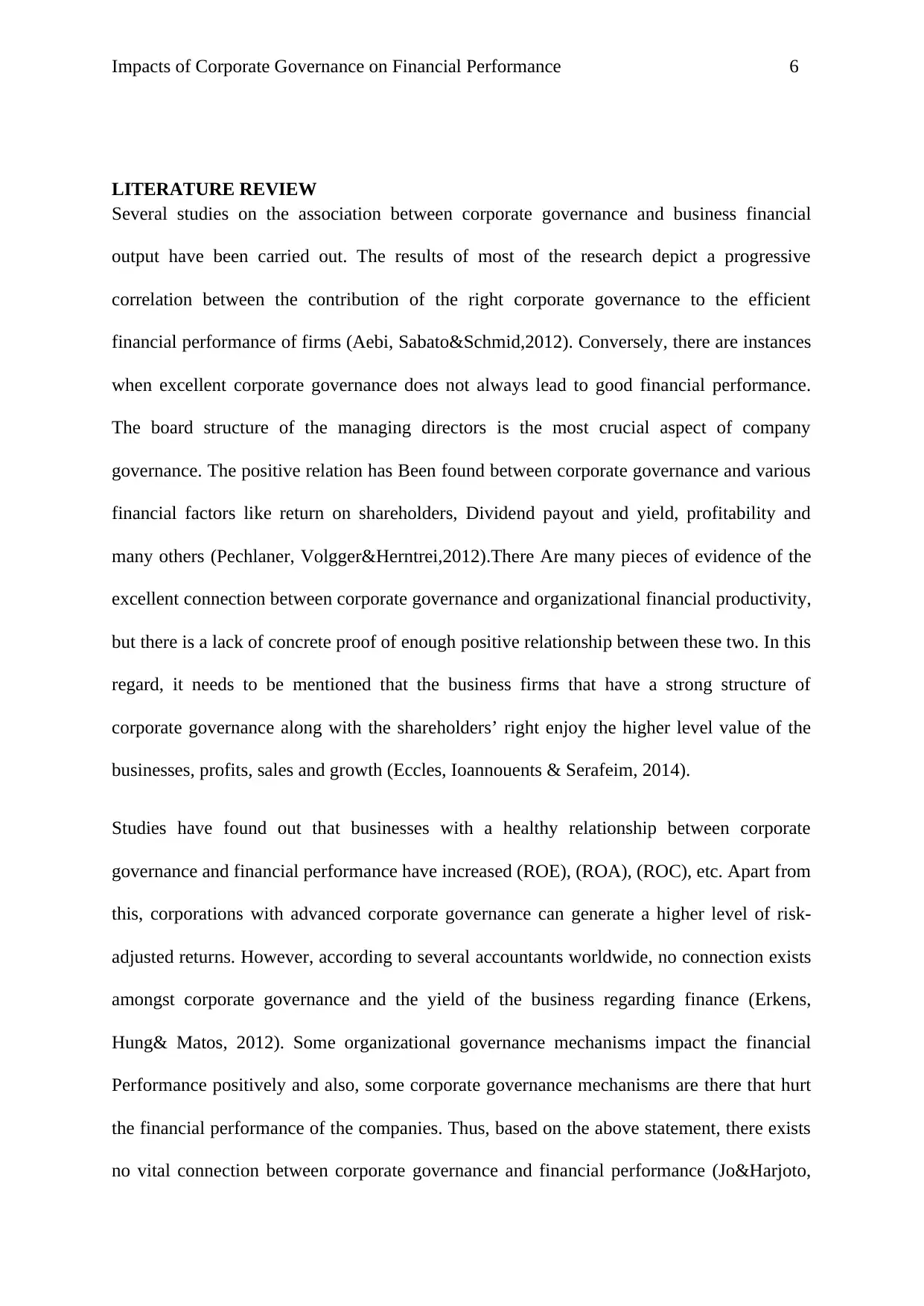
Impacts of Corporate Governance on Financial Performance 6
LITERATURE REVIEW
Several studies on the association between corporate governance and business financial
output have been carried out. The results of most of the research depict a progressive
correlation between the contribution of the right corporate governance to the efficient
financial performance of firms (Aebi, Sabato&Schmid,2012). Conversely, there are instances
when excellent corporate governance does not always lead to good financial performance.
The board structure of the managing directors is the most crucial aspect of company
governance. The positive relation has Been found between corporate governance and various
financial factors like return on shareholders, Dividend payout and yield, profitability and
many others (Pechlaner, Volgger&Herntrei,2012).There Are many pieces of evidence of the
excellent connection between corporate governance and organizational financial productivity,
but there is a lack of concrete proof of enough positive relationship between these two. In this
regard, it needs to be mentioned that the business firms that have a strong structure of
corporate governance along with the shareholders’ right enjoy the higher level value of the
businesses, profits, sales and growth (Eccles, Ioannouents & Serafeim, 2014).
Studies have found out that businesses with a healthy relationship between corporate
governance and financial performance have increased (ROE), (ROA), (ROC), etc. Apart from
this, corporations with advanced corporate governance can generate a higher level of risk-
adjusted returns. However, according to several accountants worldwide, no connection exists
amongst corporate governance and the yield of the business regarding finance (Erkens,
Hung& Matos, 2012). Some organizational governance mechanisms impact the financial
Performance positively and also, some corporate governance mechanisms are there that hurt
the financial performance of the companies. Thus, based on the above statement, there exists
no vital connection between corporate governance and financial performance (Jo&Harjoto,
LITERATURE REVIEW
Several studies on the association between corporate governance and business financial
output have been carried out. The results of most of the research depict a progressive
correlation between the contribution of the right corporate governance to the efficient
financial performance of firms (Aebi, Sabato&Schmid,2012). Conversely, there are instances
when excellent corporate governance does not always lead to good financial performance.
The board structure of the managing directors is the most crucial aspect of company
governance. The positive relation has Been found between corporate governance and various
financial factors like return on shareholders, Dividend payout and yield, profitability and
many others (Pechlaner, Volgger&Herntrei,2012).There Are many pieces of evidence of the
excellent connection between corporate governance and organizational financial productivity,
but there is a lack of concrete proof of enough positive relationship between these two. In this
regard, it needs to be mentioned that the business firms that have a strong structure of
corporate governance along with the shareholders’ right enjoy the higher level value of the
businesses, profits, sales and growth (Eccles, Ioannouents & Serafeim, 2014).
Studies have found out that businesses with a healthy relationship between corporate
governance and financial performance have increased (ROE), (ROA), (ROC), etc. Apart from
this, corporations with advanced corporate governance can generate a higher level of risk-
adjusted returns. However, according to several accountants worldwide, no connection exists
amongst corporate governance and the yield of the business regarding finance (Erkens,
Hung& Matos, 2012). Some organizational governance mechanisms impact the financial
Performance positively and also, some corporate governance mechanisms are there that hurt
the financial performance of the companies. Thus, based on the above statement, there exists
no vital connection between corporate governance and financial performance (Jo&Harjoto,
⊘ This is a preview!⊘
Do you want full access?
Subscribe today to unlock all pages.

Trusted by 1+ million students worldwide
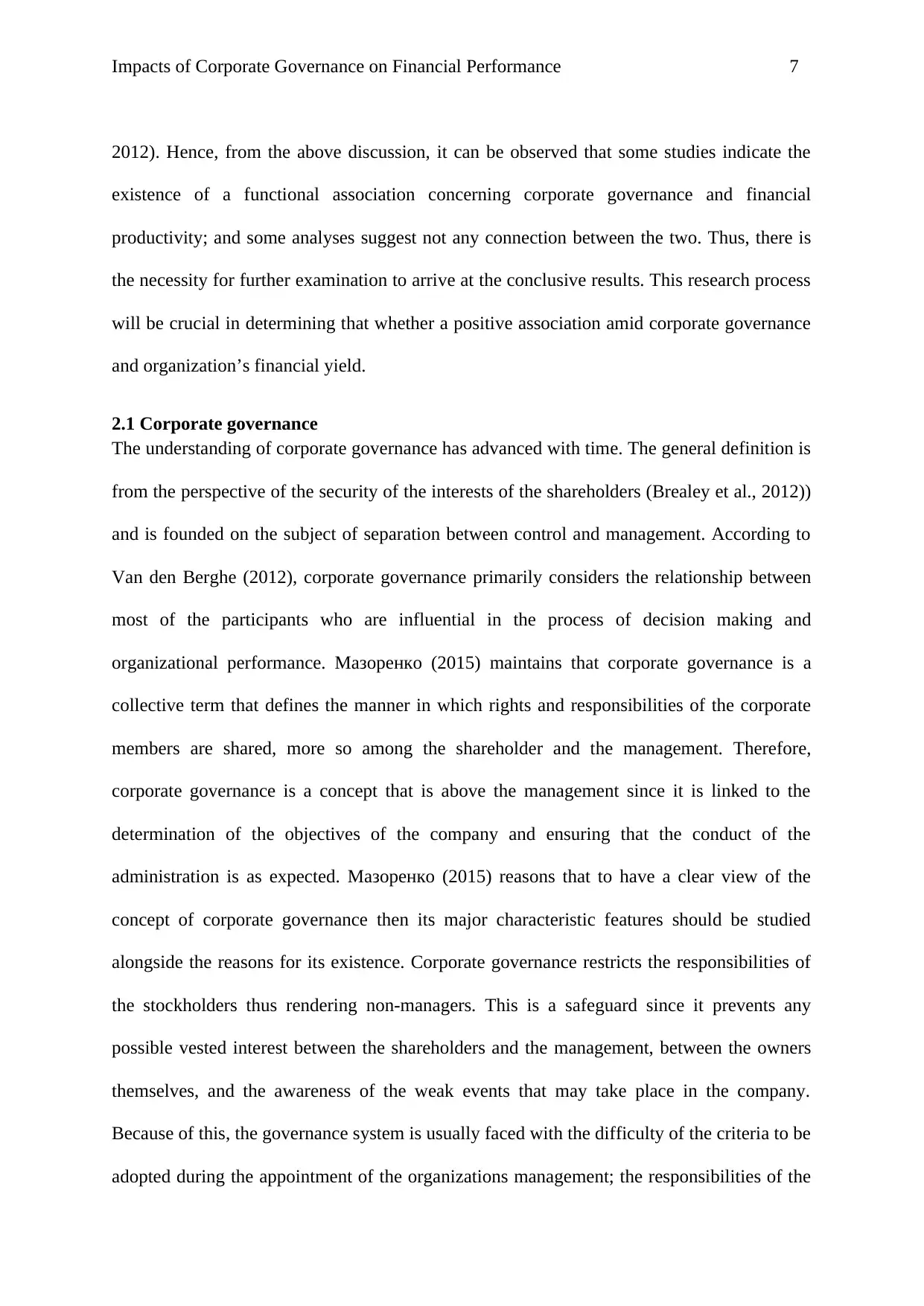
Impacts of Corporate Governance on Financial Performance 7
2012). Hence, from the above discussion, it can be observed that some studies indicate the
existence of a functional association concerning corporate governance and financial
productivity; and some analyses suggest not any connection between the two. Thus, there is
the necessity for further examination to arrive at the conclusive results. This research process
will be crucial in determining that whether a positive association amid corporate governance
and organization’s financial yield.
2.1 Corporate governance
The understanding of corporate governance has advanced with time. The general definition is
from the perspective of the security of the interests of the shareholders (Brealey et al., 2012))
and is founded on the subject of separation between control and management. According to
Van den Berghe (2012), corporate governance primarily considers the relationship between
most of the participants who are influential in the process of decision making and
organizational performance. Мазоренко (2015) maintains that corporate governance is a
collective term that defines the manner in which rights and responsibilities of the corporate
members are shared, more so among the shareholder and the management. Therefore,
corporate governance is a concept that is above the management since it is linked to the
determination of the objectives of the company and ensuring that the conduct of the
administration is as expected. Мазоренко (2015) reasons that to have a clear view of the
concept of corporate governance then its major characteristic features should be studied
alongside the reasons for its existence. Corporate governance restricts the responsibilities of
the stockholders thus rendering non-managers. This is a safeguard since it prevents any
possible vested interest between the shareholders and the management, between the owners
themselves, and the awareness of the weak events that may take place in the company.
Because of this, the governance system is usually faced with the difficulty of the criteria to be
adopted during the appointment of the organizations management; the responsibilities of the
2012). Hence, from the above discussion, it can be observed that some studies indicate the
existence of a functional association concerning corporate governance and financial
productivity; and some analyses suggest not any connection between the two. Thus, there is
the necessity for further examination to arrive at the conclusive results. This research process
will be crucial in determining that whether a positive association amid corporate governance
and organization’s financial yield.
2.1 Corporate governance
The understanding of corporate governance has advanced with time. The general definition is
from the perspective of the security of the interests of the shareholders (Brealey et al., 2012))
and is founded on the subject of separation between control and management. According to
Van den Berghe (2012), corporate governance primarily considers the relationship between
most of the participants who are influential in the process of decision making and
organizational performance. Мазоренко (2015) maintains that corporate governance is a
collective term that defines the manner in which rights and responsibilities of the corporate
members are shared, more so among the shareholder and the management. Therefore,
corporate governance is a concept that is above the management since it is linked to the
determination of the objectives of the company and ensuring that the conduct of the
administration is as expected. Мазоренко (2015) reasons that to have a clear view of the
concept of corporate governance then its major characteristic features should be studied
alongside the reasons for its existence. Corporate governance restricts the responsibilities of
the stockholders thus rendering non-managers. This is a safeguard since it prevents any
possible vested interest between the shareholders and the management, between the owners
themselves, and the awareness of the weak events that may take place in the company.
Because of this, the governance system is usually faced with the difficulty of the criteria to be
adopted during the appointment of the organizations management; the responsibilities of the
Paraphrase This Document
Need a fresh take? Get an instant paraphrase of this document with our AI Paraphraser
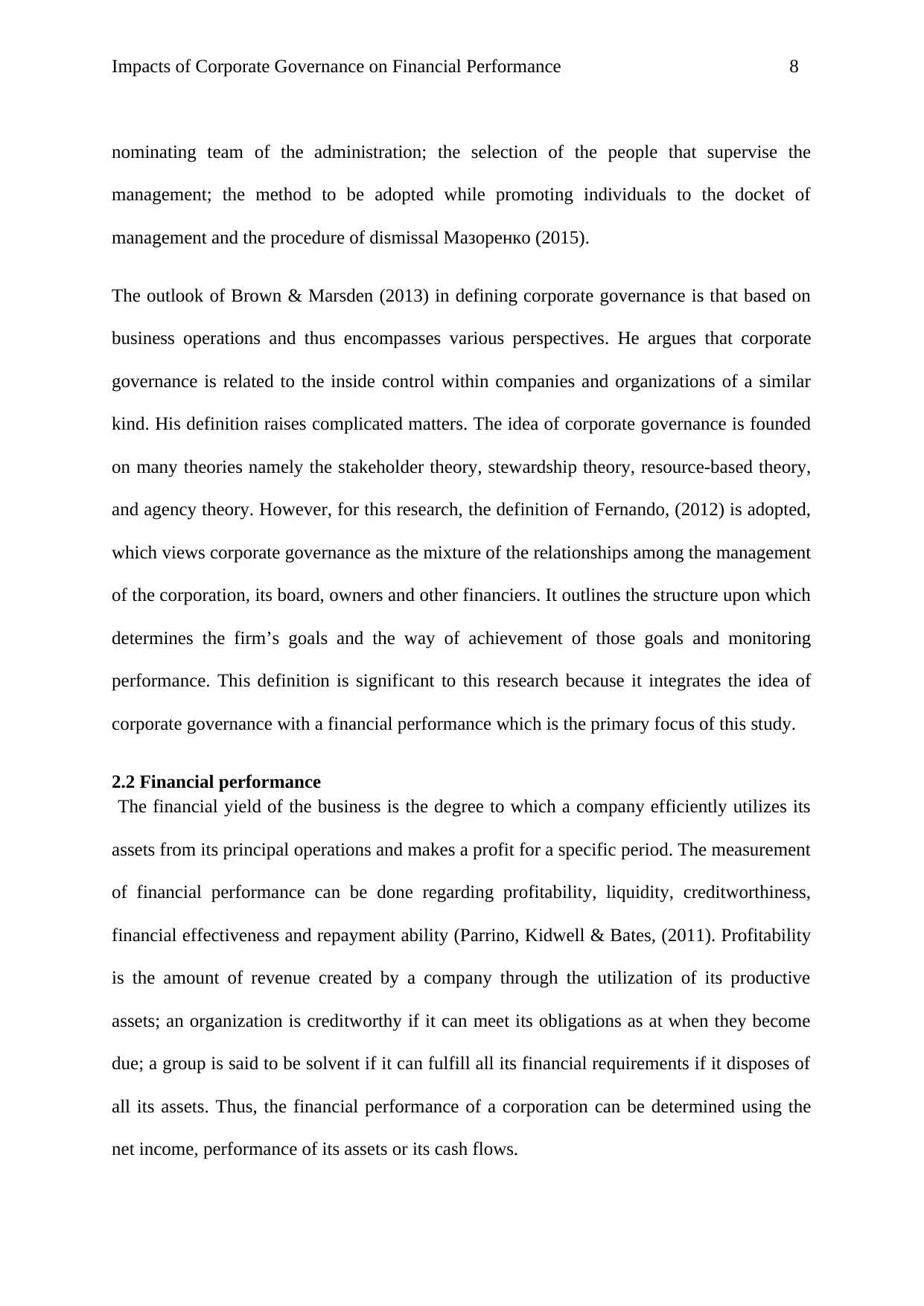
Impacts of Corporate Governance on Financial Performance 8
nominating team of the administration; the selection of the people that supervise the
management; the method to be adopted while promoting individuals to the docket of
management and the procedure of dismissal Мазоренко (2015).
The outlook of Brown & Marsden (2013) in defining corporate governance is that based on
business operations and thus encompasses various perspectives. He argues that corporate
governance is related to the inside control within companies and organizations of a similar
kind. His definition raises complicated matters. The idea of corporate governance is founded
on many theories namely the stakeholder theory, stewardship theory, resource-based theory,
and agency theory. However, for this research, the definition of Fernando, (2012) is adopted,
which views corporate governance as the mixture of the relationships among the management
of the corporation, its board, owners and other financiers. It outlines the structure upon which
determines the firm’s goals and the way of achievement of those goals and monitoring
performance. This definition is significant to this research because it integrates the idea of
corporate governance with a financial performance which is the primary focus of this study.
2.2 Financial performance
The financial yield of the business is the degree to which a company efficiently utilizes its
assets from its principal operations and makes a profit for a specific period. The measurement
of financial performance can be done regarding profitability, liquidity, creditworthiness,
financial effectiveness and repayment ability (Parrino, Kidwell & Bates, (2011). Profitability
is the amount of revenue created by a company through the utilization of its productive
assets; an organization is creditworthy if it can meet its obligations as at when they become
due; a group is said to be solvent if it can fulfill all its financial requirements if it disposes of
all its assets. Thus, the financial performance of a corporation can be determined using the
net income, performance of its assets or its cash flows.
nominating team of the administration; the selection of the people that supervise the
management; the method to be adopted while promoting individuals to the docket of
management and the procedure of dismissal Мазоренко (2015).
The outlook of Brown & Marsden (2013) in defining corporate governance is that based on
business operations and thus encompasses various perspectives. He argues that corporate
governance is related to the inside control within companies and organizations of a similar
kind. His definition raises complicated matters. The idea of corporate governance is founded
on many theories namely the stakeholder theory, stewardship theory, resource-based theory,
and agency theory. However, for this research, the definition of Fernando, (2012) is adopted,
which views corporate governance as the mixture of the relationships among the management
of the corporation, its board, owners and other financiers. It outlines the structure upon which
determines the firm’s goals and the way of achievement of those goals and monitoring
performance. This definition is significant to this research because it integrates the idea of
corporate governance with a financial performance which is the primary focus of this study.
2.2 Financial performance
The financial yield of the business is the degree to which a company efficiently utilizes its
assets from its principal operations and makes a profit for a specific period. The measurement
of financial performance can be done regarding profitability, liquidity, creditworthiness,
financial effectiveness and repayment ability (Parrino, Kidwell & Bates, (2011). Profitability
is the amount of revenue created by a company through the utilization of its productive
assets; an organization is creditworthy if it can meet its obligations as at when they become
due; a group is said to be solvent if it can fulfill all its financial requirements if it disposes of
all its assets. Thus, the financial performance of a corporation can be determined using the
net income, performance of its assets or its cash flows.
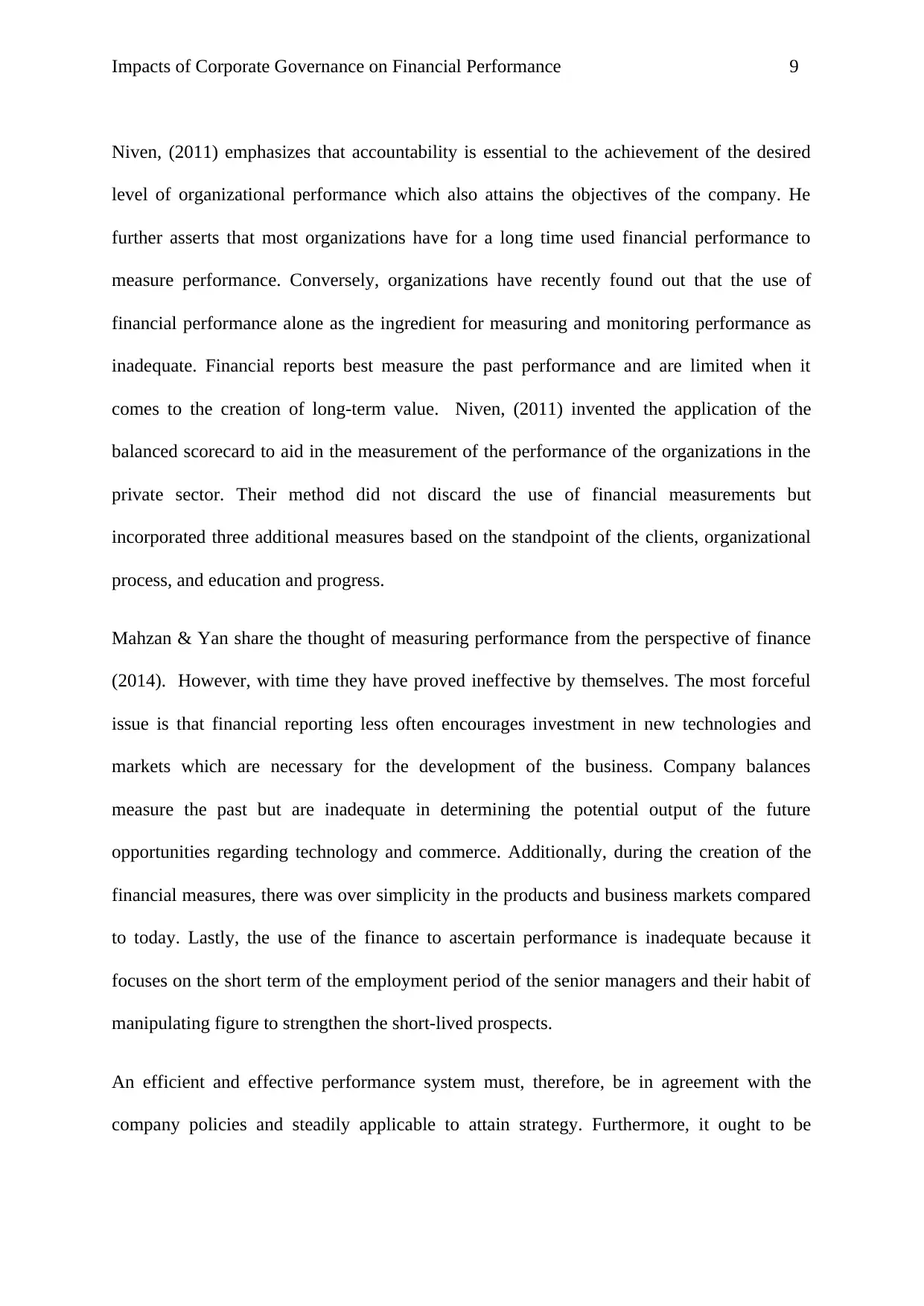
Impacts of Corporate Governance on Financial Performance 9
Niven, (2011) emphasizes that accountability is essential to the achievement of the desired
level of organizational performance which also attains the objectives of the company. He
further asserts that most organizations have for a long time used financial performance to
measure performance. Conversely, organizations have recently found out that the use of
financial performance alone as the ingredient for measuring and monitoring performance as
inadequate. Financial reports best measure the past performance and are limited when it
comes to the creation of long-term value. Niven, (2011) invented the application of the
balanced scorecard to aid in the measurement of the performance of the organizations in the
private sector. Their method did not discard the use of financial measurements but
incorporated three additional measures based on the standpoint of the clients, organizational
process, and education and progress.
Mahzan & Yan share the thought of measuring performance from the perspective of finance
(2014). However, with time they have proved ineffective by themselves. The most forceful
issue is that financial reporting less often encourages investment in new technologies and
markets which are necessary for the development of the business. Company balances
measure the past but are inadequate in determining the potential output of the future
opportunities regarding technology and commerce. Additionally, during the creation of the
financial measures, there was over simplicity in the products and business markets compared
to today. Lastly, the use of the finance to ascertain performance is inadequate because it
focuses on the short term of the employment period of the senior managers and their habit of
manipulating figure to strengthen the short-lived prospects.
An efficient and effective performance system must, therefore, be in agreement with the
company policies and steadily applicable to attain strategy. Furthermore, it ought to be
Niven, (2011) emphasizes that accountability is essential to the achievement of the desired
level of organizational performance which also attains the objectives of the company. He
further asserts that most organizations have for a long time used financial performance to
measure performance. Conversely, organizations have recently found out that the use of
financial performance alone as the ingredient for measuring and monitoring performance as
inadequate. Financial reports best measure the past performance and are limited when it
comes to the creation of long-term value. Niven, (2011) invented the application of the
balanced scorecard to aid in the measurement of the performance of the organizations in the
private sector. Their method did not discard the use of financial measurements but
incorporated three additional measures based on the standpoint of the clients, organizational
process, and education and progress.
Mahzan & Yan share the thought of measuring performance from the perspective of finance
(2014). However, with time they have proved ineffective by themselves. The most forceful
issue is that financial reporting less often encourages investment in new technologies and
markets which are necessary for the development of the business. Company balances
measure the past but are inadequate in determining the potential output of the future
opportunities regarding technology and commerce. Additionally, during the creation of the
financial measures, there was over simplicity in the products and business markets compared
to today. Lastly, the use of the finance to ascertain performance is inadequate because it
focuses on the short term of the employment period of the senior managers and their habit of
manipulating figure to strengthen the short-lived prospects.
An efficient and effective performance system must, therefore, be in agreement with the
company policies and steadily applicable to attain strategy. Furthermore, it ought to be
⊘ This is a preview!⊘
Do you want full access?
Subscribe today to unlock all pages.

Trusted by 1+ million students worldwide

Impacts of Corporate Governance on Financial Performance 10
multidimensional, to take care of the most of the sectors within the corporation, its services,
and products.
2.3 Components of Corporate Governance
2.3.1 CEO duality
The duality of the CEO-Chairman is the situation in which the CEO besides serves as the
chair of the board of directors. Yang & Zhao (2014) relates this as a hindrance to the
accountability of the management and limits the ability of the board in carrying out its roles
independently because the fundamental duty of the board chair is to oversee the activities of
the senior executives. A survey research on 452 firms ranked as the 500 most significant
public firms in the US in the Forbes Magazine’s was conducted by Fauzi & Locke (2012), the
outcomes revealed that company value is higher when the CEO and the board chair positions
are distinct.
2.3.2 Board size
The board size should be moderate, neither too larger nor too small. Most of the Companies
Act does not provide for the exact board size but the upper and lower limits. For instance, the
guidelines on corporate governance by the Capital Markets Authority (CMA, 2002 cited by
Waweru, (2014) suggests that the board size should not be overly broad for this will
complicate an active deliberation of the board meetings or excessively small because it will
exclude the broader skills and expertise that are needed for the adequate board performance.
A small board size will suffer the scarcity of knowledge, whereas a significant board size will
increase conflicts (Guillaume et al., 2012); and it may weaken the process of decision making
through the frequent interruptions or difficulty in coordination (Claessens & Yurtoglu,
(2013). Kumar & Singh (2013) revisits similar arguments that a board size that is larger ins
size has a complex process of decision making. The board size and the Topic Q of the
multidimensional, to take care of the most of the sectors within the corporation, its services,
and products.
2.3 Components of Corporate Governance
2.3.1 CEO duality
The duality of the CEO-Chairman is the situation in which the CEO besides serves as the
chair of the board of directors. Yang & Zhao (2014) relates this as a hindrance to the
accountability of the management and limits the ability of the board in carrying out its roles
independently because the fundamental duty of the board chair is to oversee the activities of
the senior executives. A survey research on 452 firms ranked as the 500 most significant
public firms in the US in the Forbes Magazine’s was conducted by Fauzi & Locke (2012), the
outcomes revealed that company value is higher when the CEO and the board chair positions
are distinct.
2.3.2 Board size
The board size should be moderate, neither too larger nor too small. Most of the Companies
Act does not provide for the exact board size but the upper and lower limits. For instance, the
guidelines on corporate governance by the Capital Markets Authority (CMA, 2002 cited by
Waweru, (2014) suggests that the board size should not be overly broad for this will
complicate an active deliberation of the board meetings or excessively small because it will
exclude the broader skills and expertise that are needed for the adequate board performance.
A small board size will suffer the scarcity of knowledge, whereas a significant board size will
increase conflicts (Guillaume et al., 2012); and it may weaken the process of decision making
through the frequent interruptions or difficulty in coordination (Claessens & Yurtoglu,
(2013). Kumar & Singh (2013) revisits similar arguments that a board size that is larger ins
size has a complex process of decision making. The board size and the Topic Q of the
Paraphrase This Document
Need a fresh take? Get an instant paraphrase of this document with our AI Paraphraser
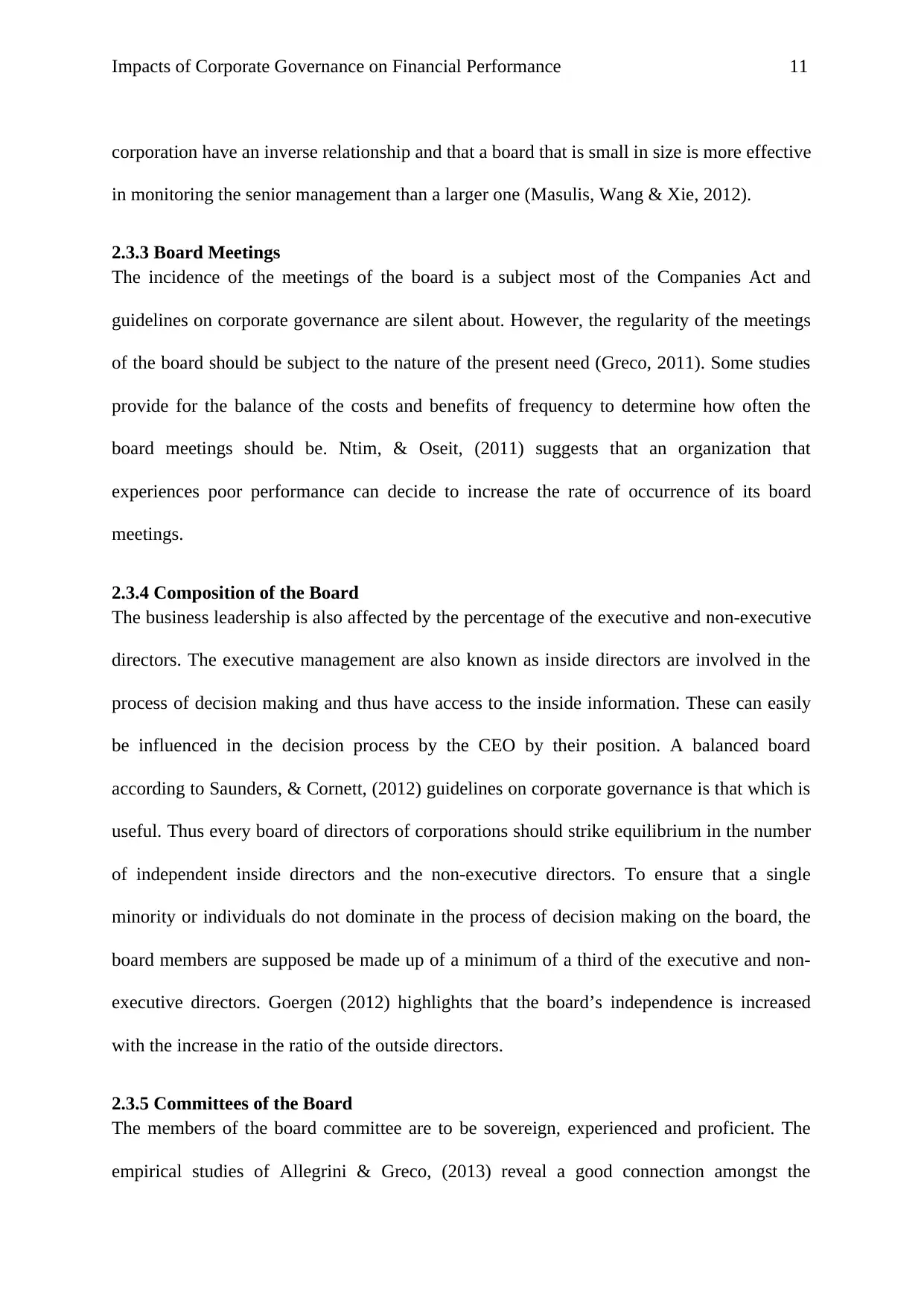
Impacts of Corporate Governance on Financial Performance 11
corporation have an inverse relationship and that a board that is small in size is more effective
in monitoring the senior management than a larger one (Masulis, Wang & Xie, 2012).
2.3.3 Board Meetings
The incidence of the meetings of the board is a subject most of the Companies Act and
guidelines on corporate governance are silent about. However, the regularity of the meetings
of the board should be subject to the nature of the present need (Greco, 2011). Some studies
provide for the balance of the costs and benefits of frequency to determine how often the
board meetings should be. Ntim, & Oseit, (2011) suggests that an organization that
experiences poor performance can decide to increase the rate of occurrence of its board
meetings.
2.3.4 Composition of the Board
The business leadership is also affected by the percentage of the executive and non-executive
directors. The executive management are also known as inside directors are involved in the
process of decision making and thus have access to the inside information. These can easily
be influenced in the decision process by the CEO by their position. A balanced board
according to Saunders, & Cornett, (2012) guidelines on corporate governance is that which is
useful. Thus every board of directors of corporations should strike equilibrium in the number
of independent inside directors and the non-executive directors. To ensure that a single
minority or individuals do not dominate in the process of decision making on the board, the
board members are supposed be made up of a minimum of a third of the executive and non-
executive directors. Goergen (2012) highlights that the board’s independence is increased
with the increase in the ratio of the outside directors.
2.3.5 Committees of the Board
The members of the board committee are to be sovereign, experienced and proficient. The
empirical studies of Allegrini & Greco, (2013) reveal a good connection amongst the
corporation have an inverse relationship and that a board that is small in size is more effective
in monitoring the senior management than a larger one (Masulis, Wang & Xie, 2012).
2.3.3 Board Meetings
The incidence of the meetings of the board is a subject most of the Companies Act and
guidelines on corporate governance are silent about. However, the regularity of the meetings
of the board should be subject to the nature of the present need (Greco, 2011). Some studies
provide for the balance of the costs and benefits of frequency to determine how often the
board meetings should be. Ntim, & Oseit, (2011) suggests that an organization that
experiences poor performance can decide to increase the rate of occurrence of its board
meetings.
2.3.4 Composition of the Board
The business leadership is also affected by the percentage of the executive and non-executive
directors. The executive management are also known as inside directors are involved in the
process of decision making and thus have access to the inside information. These can easily
be influenced in the decision process by the CEO by their position. A balanced board
according to Saunders, & Cornett, (2012) guidelines on corporate governance is that which is
useful. Thus every board of directors of corporations should strike equilibrium in the number
of independent inside directors and the non-executive directors. To ensure that a single
minority or individuals do not dominate in the process of decision making on the board, the
board members are supposed be made up of a minimum of a third of the executive and non-
executive directors. Goergen (2012) highlights that the board’s independence is increased
with the increase in the ratio of the outside directors.
2.3.5 Committees of the Board
The members of the board committee are to be sovereign, experienced and proficient. The
empirical studies of Allegrini & Greco, (2013) reveal a good connection amongst the
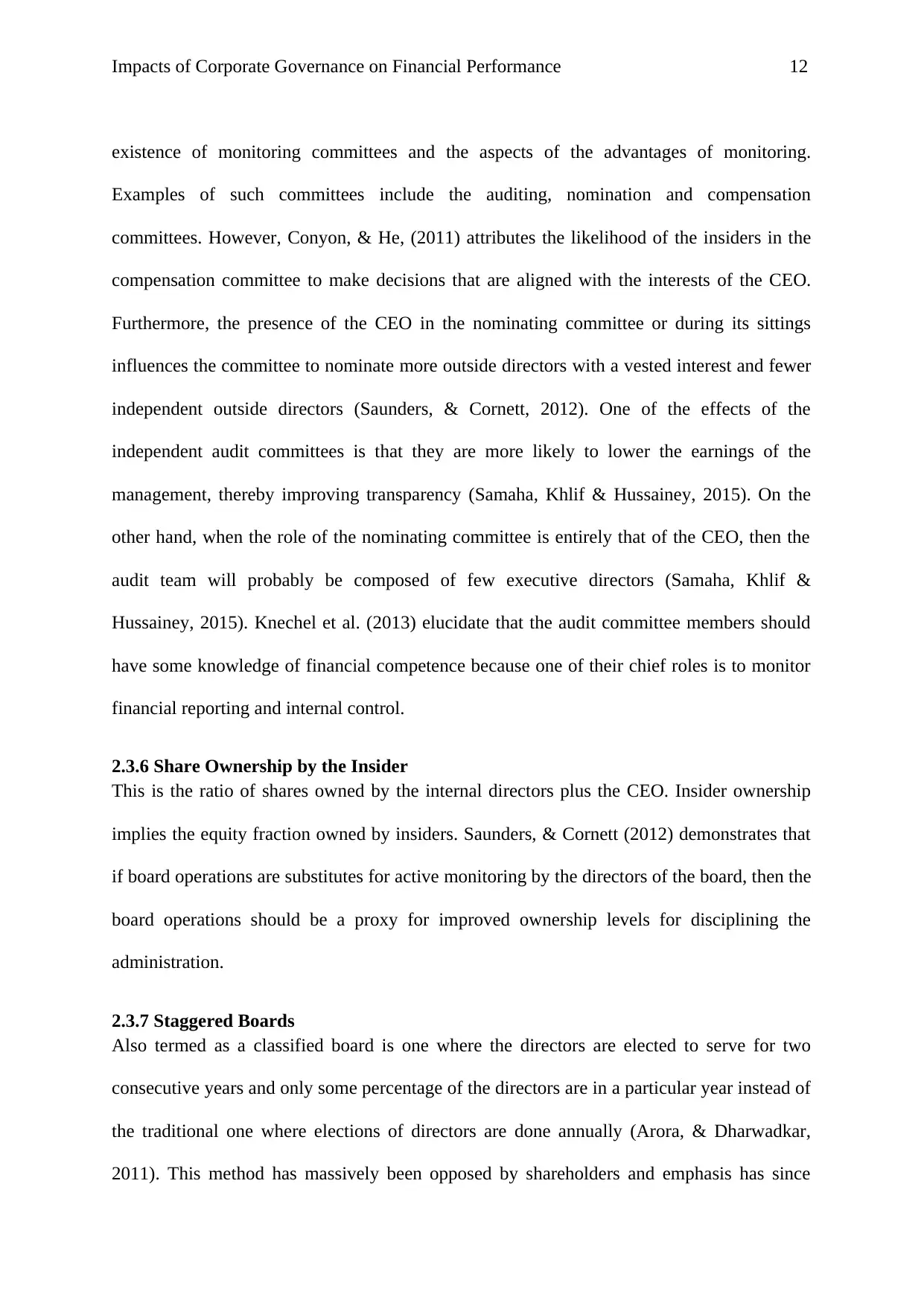
Impacts of Corporate Governance on Financial Performance 12
existence of monitoring committees and the aspects of the advantages of monitoring.
Examples of such committees include the auditing, nomination and compensation
committees. However, Conyon, & He, (2011) attributes the likelihood of the insiders in the
compensation committee to make decisions that are aligned with the interests of the CEO.
Furthermore, the presence of the CEO in the nominating committee or during its sittings
influences the committee to nominate more outside directors with a vested interest and fewer
independent outside directors (Saunders, & Cornett, 2012). One of the effects of the
independent audit committees is that they are more likely to lower the earnings of the
management, thereby improving transparency (Samaha, Khlif & Hussainey, 2015). On the
other hand, when the role of the nominating committee is entirely that of the CEO, then the
audit team will probably be composed of few executive directors (Samaha, Khlif &
Hussainey, 2015). Knechel et al. (2013) elucidate that the audit committee members should
have some knowledge of financial competence because one of their chief roles is to monitor
financial reporting and internal control.
2.3.6 Share Ownership by the Insider
This is the ratio of shares owned by the internal directors plus the CEO. Insider ownership
implies the equity fraction owned by insiders. Saunders, & Cornett (2012) demonstrates that
if board operations are substitutes for active monitoring by the directors of the board, then the
board operations should be a proxy for improved ownership levels for disciplining the
administration.
2.3.7 Staggered Boards
Also termed as a classified board is one where the directors are elected to serve for two
consecutive years and only some percentage of the directors are in a particular year instead of
the traditional one where elections of directors are done annually (Arora, & Dharwadkar,
2011). This method has massively been opposed by shareholders and emphasis has since
existence of monitoring committees and the aspects of the advantages of monitoring.
Examples of such committees include the auditing, nomination and compensation
committees. However, Conyon, & He, (2011) attributes the likelihood of the insiders in the
compensation committee to make decisions that are aligned with the interests of the CEO.
Furthermore, the presence of the CEO in the nominating committee or during its sittings
influences the committee to nominate more outside directors with a vested interest and fewer
independent outside directors (Saunders, & Cornett, 2012). One of the effects of the
independent audit committees is that they are more likely to lower the earnings of the
management, thereby improving transparency (Samaha, Khlif & Hussainey, 2015). On the
other hand, when the role of the nominating committee is entirely that of the CEO, then the
audit team will probably be composed of few executive directors (Samaha, Khlif &
Hussainey, 2015). Knechel et al. (2013) elucidate that the audit committee members should
have some knowledge of financial competence because one of their chief roles is to monitor
financial reporting and internal control.
2.3.6 Share Ownership by the Insider
This is the ratio of shares owned by the internal directors plus the CEO. Insider ownership
implies the equity fraction owned by insiders. Saunders, & Cornett (2012) demonstrates that
if board operations are substitutes for active monitoring by the directors of the board, then the
board operations should be a proxy for improved ownership levels for disciplining the
administration.
2.3.7 Staggered Boards
Also termed as a classified board is one where the directors are elected to serve for two
consecutive years and only some percentage of the directors are in a particular year instead of
the traditional one where elections of directors are done annually (Arora, & Dharwadkar,
2011). This method has massively been opposed by shareholders and emphasis has since
⊘ This is a preview!⊘
Do you want full access?
Subscribe today to unlock all pages.

Trusted by 1+ million students worldwide
1 out of 33
Related Documents
Your All-in-One AI-Powered Toolkit for Academic Success.
+13062052269
info@desklib.com
Available 24*7 on WhatsApp / Email
![[object Object]](/_next/static/media/star-bottom.7253800d.svg)
Unlock your academic potential
Copyright © 2020–2026 A2Z Services. All Rights Reserved. Developed and managed by ZUCOL.





